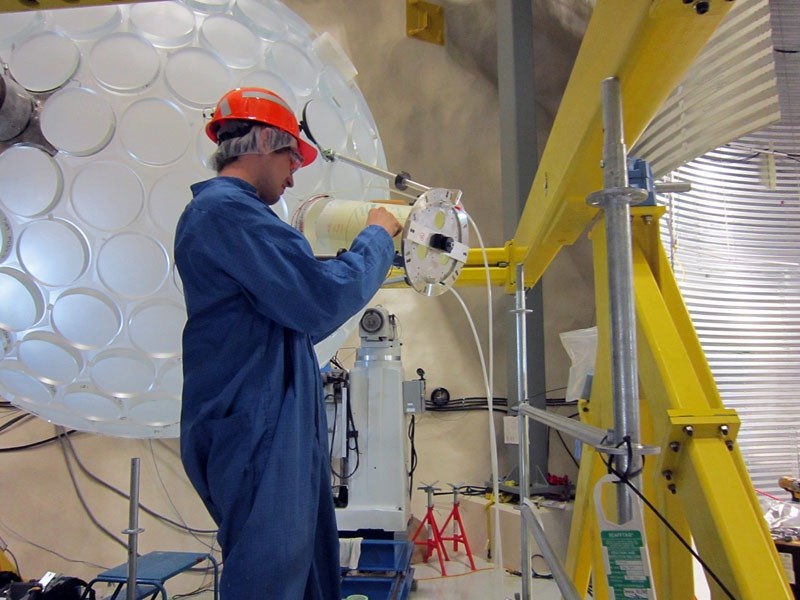On any given day you can catch Rhys Chouinard crunching numbers for the City of St. Albert.
As senior corporate analyst, Chouinard keeps a pulse on the economic trends that affect the businesses and residents of our city.
But before becoming a municipal employee – using his problem solving and mathematical powers “for the good of the common taxpayer” – Chouinard studied a very different kind of pulse.
Three years ago, as a master’s student in the University of Alberta’s physics department, Chouinard helped design what will soon become the world’s most sensitive dark matter detector.
DEAP 3600 is a collaboration between four Canadian institutions, as well as a few other international partners. The University of Alberta played a critical role in the construction of the dark matter detector, which is currently cooling down in North America’s deepest underground scientific laboratory, SNOLAB, near Sudbury, Ont.
Dark matter particles are a bit of a mystery.
They neither absorb nor emit light (making them completely invisible) and have very little interaction with other matter. They’re WIMPs, that is to say Weakly Interacting Massive Particles, making them one of the hardest particles to detect.
Yet, we know they exist.
In some ways dark matter acts a lot like regular matter. It has a mass and therefore a gravitational pull – the effects of which scientists have noted while studying the universe.
“You can think of it this way: if you’re inside of a house and you’re trying to determine if it’s windy outside or not, you’ll look at the wind’s effect on visible things,” explained Chouinard. “When you look outside and see the trees blowing you know there’s wind out there even though you can’t see it.”
Similarly, dark matter’s effect on stars can be observed. Without dark matter (and its gravitational pull) galaxies would be spinning too fast to stay intact.
Chouinard started working on DEAP as an undergraduate. His task was figuring out how to bond the light guides (containing the sensors) to the outside of the inner vessel – a two-metre-wide acrylic sphere that would be filled with liquid argon.
A cryogenic liquid (or liquefied gas), argon has a boiling point of -186°C, so not exactly an easy task.
To test his work he would immerse bonded pieces of acrylic into liquid nitrogen, hoping they wouldn’t shatter.
Chouinard continued working on DEAP throughout his master’s degree, building custom electronics and running simulations.
In the final year of his master’s, he ran over a million fake events to ensure the detector was sensitive enough to catch and distinguish dark matter events.
Despite the “antisocial” nature of dark matter, the DEAP team is hoping the particles will interact with the 565 imperial gallons of argon in the detector. A collision would in theory send the nucleus recoiling – creating a flash of ultraviolet light that should be picked up by light sensors powerful enough, Chouinard says, to detect a single lighter flame from the moon.
Chouinard became fascinated with particle physics when professors stopped being able to answer his incessant questioning.
“I didn’t believe them,” he said.
A skeptic, Chouinard questioned just about every theory he learned, from relativity to quantum mechanics, until eventually, in his fourth year, his professors would say “No, that’s the limit of our human understanding.”
He was hooked. However, unravelling the mysteries of the universe also comes with 80-hour weeks and very little sleep. A little burnt out and unsure about a life in academia, Chouinard decided to take a step back.
Luckily he still has former colleague Thomas McElroy to check in with when he needs his dose of astrophysics.
The St. Albert native and PhD student took up where his colleague left off.
After Chouinard submitted his thesis to the faculty of graduate studies in spring 2013, McElroy travelled to Sudbury to bond the light guides (which hold the sensors) to the detector’s inner vessel.
Every day for six months, McElroy would slip into his coveralls, mine belt, hard hat and boots and travel two kilometres underground to a clean lab – showering and changing before he could enter.
“We have to do a lot to get rid of anything that’s radioactive near our detector,” he explained. Dirt can contain radon, uranium and other particles capable of throwing off the whole experiment by creating what scientists call background noise.
As another precaution, a specially-designed sanding robot was sent down into the airtight neck last summer to strip away a millimeter from the interior surface of the inner chamber, removing any radon it may have absorbed over the 18-month assembly period.
In about a month and a half the experiment will go online, says physics professor and DEAP collaborator Aksel Hallin. Currently, the detector is cooling off.
The last step is to pour the argon in and wait three years to see if something happens.
If it does the DEAP team will have solved one of the greatest scientific mysteries of our time. (About five per cent of the universe is currently understood – this discovery would bump that number to 31.)
And if doesn’t? That’s OK, say Hallin and McElroy.
Too many events would likely be a sign of “too dirty of a detector.”
None, on the other hand, would prove that DEAP 3600 is indeed the world’s most sensitive detector.
“We can’t control whether or not dark matter is there,” said McElroy, “but we can control how well we built our detector. If we see nothing then we’ve made a great detector that’s nice and clean. It didn’t detect a signal that wasn’t there.”
Either way, for a young scientist who hopes to land a post-doctorate position in particle physics, the results are highly anticipated.
Chouinard is also looking forward to the results.
And given he helped build the detector, he’d be satisfied with the answer.




